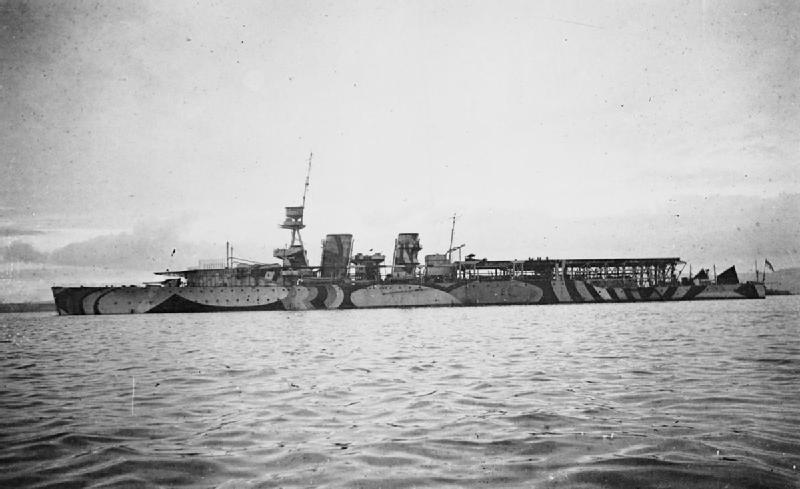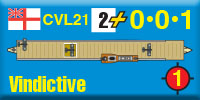Tropic of Capricorn:
The Royal Navy, Part One
by Mike Bennighof, Ph.D.
August 2021
 Our Second Great War at Sea: Tropic of Capricorn is an unusual game, based on an alternative-history conflict that didn’t actually happen, between two fleets that didn’t actually fight in the real Second World War. During the course of the story, Argentina is helped by two others fleets: those of long-time rival Chile, and Chile’s European patron, Britain. Our Second Great War at Sea: Tropic of Capricorn is an unusual game, based on an alternative-history conflict that didn’t actually happen, between two fleets that didn’t actually fight in the real Second World War. During the course of the story, Argentina is helped by two others fleets: those of long-time rival Chile, and Chile’s European patron, Britain.
I designed the Second Great War setting (or, more accurately, stumbled into it on developer Jim Stear’s direction) as a battleship game – an excuse to take all of those battleships in various Second World War at Sea games, add still more battleships, and have them fight. All in the context of an over-arching story line, one grounded in historical possibilities.
While all of the navies involved in the Second Great War at Sea are centered on the battleship, I wanted to make an exception: Britain’s Royal Navy. The British did build the world’s first aircraft carrier in the real world, and they do so in this imaginary one as well. They don’t have the same high-performance aircraft as in the actual history; even the fabric-covered Swordfish is a superior plane to what the Fleet Air Arm can field in this time-line.
In Tropic of Capricorn, a small British carrier task force arrives to briefly assist the Argentines in their efforts to send convoys to and from their European allies. The carriers are a definite force multiplier for the Entente side; let’s take a look at the British forces.
The Light Aircraft Carrier
The cruiser Cavendish, later re-named Vindictive, began conversion to an aircraft carrier in June 1917. She had been laid down as a Hawkins-class cruiser one year earlier at the private Harland & Wolff yard in Belfast (builders of the Titanic), but construction had slowed under the pressure of many other needs and she had not yet been launched.
During conversion, she lost three of her seven 7.5-inch guns and had a “flying-on” deck fitted aft and a “flying-off” deck fitted forward. She retained all six of her torpedo tubes. A narrow gangway along the port side of the ship connected the two decks, so aircraft could be moved between them if they had their wings folded. The hangar lay underneath the flying-off deck (which formed its roof) and had no elevator; large cranes moved aircraft in or out of the hangar. Vindictive resembled a miniature version of the carrier Furious, converted at the same time from a battle cruiser, but retained more of her original armament than had the bigger ship. She could carry up to the dozen aircraft, depending on their type.

Vindictive as an aircraft carrier.
Vindictive weighed in at 9,500 tons’ displacement, for a hull 605 feet long and 65 feet wide. She could make 30 knots, with a mixed-firing power plant that burned both coal (four boilers) and oil (eight boilers). The Hawkins class was designed to range the far seas in search of enemy raiders, thus their designers felt it important that they be able to burn whatever fuel was available. She was armored against the guns of other cruisers, with a four-inch belt and an armored deck and inch and a half thick. Launched in January 1918, she completed in October of that year, just in time for the Great War to come to an end.
The end of the war did not bring an end to the fighting and dying, and Vindictive went to the Baltic to help support the White cause in the Russian Civil War. Her aircraft bombed the Reds, spotted for bombardments and shot down an observation balloon, but it proved impossible to land them on the ship while she was under way, turning her into a harbor-bound depot ship when conducting air operations. She suffered heavy grounding damage, which was fully repaired in late 1919.
In both Furious and Vindictive, the turbulence caused by the intact funnels and superstructure greatly limited the ships’ utility as aircraft carriers. Furious would eventually be converted to a through-deck carrier, but Vindictive was considered too small and she served as a troop transport before conversion back into a cruiser. She served a brief span as a training ship in the 1930’s before work began to convert her back into a cruiser; she spent the Second World War as a repair ship instead.
Vindictive in the Second Great War at Sea
In Tropic of Capricorn, the Great War would have ended before Vindictive’s conversion was complete, allowing a longer period of testing and keeping the ship out of the Baltic Sea. Vindictive was almost exactly the same size as the British escort carrier Avenger, converted from a merchant ship in 1941, and certainly could have been turned into a working aircraft carrier – though whether the expense would have been worthwhile to field such a small air group could be debated, and doubtlessly would have been.
 Like Avenger (over there on the right), Vindictive in our story has a full-length flight deck atop a full-length hangar and a single lift. Unlike Avenger, she has a small starboard-side island – had she actually been converted in the early 1920’s, she would have had this feature. Furious and Argus were built without islands, while the converted battleship Eagle and purpose-built Hermes had them from the start. Like Avenger (over there on the right), Vindictive in our story has a full-length flight deck atop a full-length hangar and a single lift. Unlike Avenger, she has a small starboard-side island – had she actually been converted in the early 1920’s, she would have had this feature. Furious and Argus were built without islands, while the converted battleship Eagle and purpose-built Hermes had them from the start.
She carries up to a dozen aircraft, but usually fewer. While large enough to serve as an aircraft carrier, she has little space for the needed workshops and other maintenance facilities, or for upgrades to her electronics and armament. In her carrier configuration Vindictive carries three four-inch guns and a smattering of 20mm Oerlikon light guns, making her quite vulnerable to enemy aircraft. Fortunately, in the world of the Second Great War there are few capable enemy attack aircraft to fear.
Vindictive has lost her coal-fired boilers (coal smoke being detrimental to air operations), as she did in our own history. With only her oil-fired boilers she made 24 knots as a training ship, which would make her too slow in her new role and so the coal-burners have been replaced to keep her speed up. At her age she would be unlikely to match her designed speed of 30 knots, with 28 knots a more realistic goal.
 In Tropic of Capricorn, Vindictive appears alone as a convoy escort; her tiny air group is actually very useful, since the Brazilians have no aircraft carriers but do have aircraft-carrying zeppelins (like I said, it’s a fun and gonzo game). She also appears with the other British carriers; she doesn’t add a lot to the British air group but this is a game where even one step of aircraft can make a major difference. In Tropic of Capricorn, Vindictive appears alone as a convoy escort; her tiny air group is actually very useful, since the Brazilians have no aircraft carriers but do have aircraft-carrying zeppelins (like I said, it’s a fun and gonzo game). She also appears with the other British carriers; she doesn’t add a lot to the British air group but this is a game where even one step of aircraft can make a major difference.
She’s useful chiefly because there are so few opposing flattops. In the actual Second World War at Sea she would have been even more vulnerable than Hermes when caught by enemy aircraft. As an escort carrier she would have had much more utility.
Click here to order Tropic of Capricorn (Playbook edition) right now!
Sign up for our newsletter right here. Your info will never be sold or transferred; we'll just use it to update you on new games and new offers.
Mike Bennighof is president of Avalanche Press and holds a doctorate in history from Emory University. A Fulbright Scholar and NASA Journalist in Space finalist, he has a whole passel of books, games and articles on historical subjects.
He lives in Birmingham, Alabama with his wife, three children and his dog, Leopold.
Want to keep Daily Content free of third-party ads? You can send us some love (and cash) through this link right here.
|
